And here are my wall paper designs. (click to enlarge, the explanation is written beside the pictures)
28 Sep
Coursework (sketching component)
Basically, the theme of my coursework is ‘A child’s dream world’. I used paper and explored paper architecture to make this world of staircases, like a maze, where the walls of the staircases are printed with pictures of what a child likes. In this structure, there is also a clay figure of a child staring at the pictures in wonderment to give the idea that this child is lost in his own dream world.
Here is the process and development of my coursework. As my coursework is a 3-D figure, most of my exploration was on making the staircase structures and lesser on 2-D works. So I have decided to split the process into sketches and digital.
(click to enlarge, the explanations are written beside the pictures.)
25 Aug
Social defense project – puppet designing (final product)
At last, we used two of the icons of Singapore: Sir Stamford Raffles and the Merlion. The designs were sent to professional puppet makers and here’s the product!
FINAL:
25 Aug
Social defense project – puppet designing
In this project, my groupmates and I were tasked to make a video showing the importance of social defense. We have decided to use puppetry in our video.
In the video, there were a few scenes where icons of Singapore appeared and I got down to designing them. I also designed the backdrop but the design was not used due to limited resources.
25 Aug
Birthday Card (:
I designed a birthday card for my friend using the theme ‘Guitar’ since her favourite pass time is playing guitar and being a rock star is where her dream lies. I came up with two designs.
First design
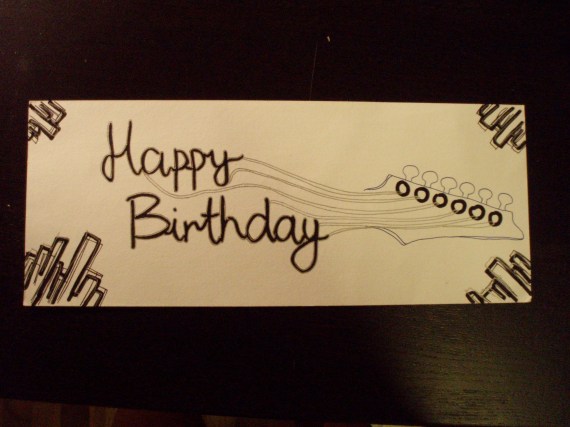
Medium: Marker, pen
Size: 30cm x 12cm
Reflections: Here, I was trying to link the guitar strings with the ‘Happy Birthday’ words. It is quite an interesting design, however I found the ‘head’ of the guitar that is half done, hanging in mid-air quite out of place.
Second design
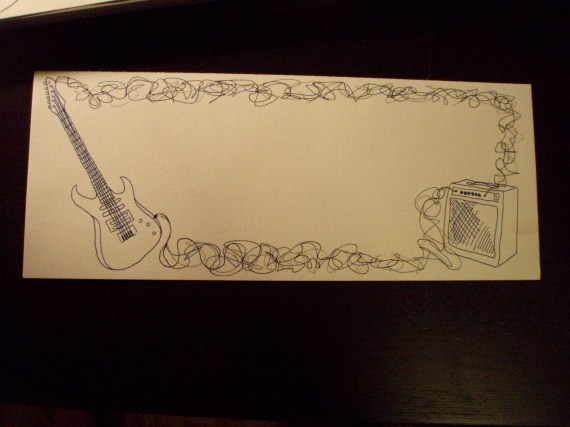
Medium: Marker, pen
Size: 30cm x 12cm
Reflections: In my second attempt, I drew a guitar and an amplifier on either side of the picture and linked them using a mess of lines to create the boarder of the card. This idea dawned on me after seeing how the wires linked the electric guitars to amplifiers; but to make the card more interesting, I drew multiple ‘wires’ exiting and entering one and used different colours for the wires such as grey, black and blue.
I like this design because it is simple, just two main objects on the card, and it leaves a lot of space for me to write.
Here is a small peek of the final product.
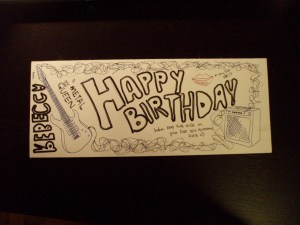
12 Jun
Surrealism – exploring
After being exposed to surrealism, I decided to look into the surrealistic art and explore deeper.
Surrealism is an anti‐rational movement of imaginative liberation in European (mainly French) art and literature in the 1920s and 1930s, launched by André Breton in his Manifeste du Surréalisme (1924) after his break from the Dada group in 1922. The term surréaliste had been used by the French poet Guillaume Apollinaire in 1917 to indicate an attempt to reach beyond the limits of the ‘real’.
Surrealism seeks to break down the boundaries between rationality and irrationality, exploring the resources and revolutionary energies of dreams, hallucinations, and sexual desire. Influenced both by the Symbolists and by Sigmund Freud’s theories of the unconscious, the surrealists experimented with automatic writing and with the free association of random images brought together in surprising juxtaposition. Although surrealist painting is better known, a significant tradition of surrealist poetry established itself in France, in the work of Breton, Paul Éluard, Louis Aragon, and Benjamin Péret.
Surrealism also attempted to become an international revolutionary movement, associated for a while with the Communist International. Although dissolved as a coherent movement by the end of the 1930s, its tradition has survived in many forms of post‐war experimental writing, from the theatre of the absurd to the songs of Bob Dylan. The adjectives surreal and surrealistic are often used in a loose sense to refer to any bizarre imaginative effect.
Examples of Surrealists:
Salvador Dalí

Dalí was a skilled draftsman, best known for the striking and bizarre images in his surrealist work. His painting skills are often attributed to the influence of Renaissance masters.His best-known work, The Persistence of Memory, was completed in 1931. Dalí’s expansive artistic repertoire includes film, sculpture, and photography, in collaboration with a range of artists in a variety of media.
The Persistence of Memory
The well-known surrealistic piece introduced the image of the soft melting pocket watch. It epitomizes Dalí’s theory of ‘softness’ and ‘hardness’, which was central to his thinking at the time. Many also consider that the melting watches were there to literally symbolize the irrelevance of time.
I think this piece is interesting. But personally, I do not this piece. I think that this painting is quite abstract and hard to understand, and i prefer paintings that explicitly expresses its theme. However, that is just my personal preference and opinion, please feel free to rebut. I do think this piece is well done and the idea of clocks being so soft and jelly is quite interesting. Staring at the whole picture gives me a serene feeling. Well, I think I can explore more artists’ works and perhaps, learn to appreciate yet another form of art.
Acknowledgements to:
http://www.answers.com/topic/surrealism
http://en.wikipedia.org/wiki/Salvador_Dal%C3%AD
http://www.where.ca/travel/index.php/toronto/2009/05/09/ago-surreal-things/
12 Jun
Surrealism painting
After being exposed to works of famous artists about surrealism, such as Salvador Dali, Rene Magritte, Yves Tanguy, Joan Miro etc. we are tasked to create our own works on surrealism. To start off with it, we went around the school taking pictures for our work and photoshoped them into a the final draft of what we wanted to paint. After we’re done, we could paint our final by refering to the draft.
Title: Surrealism
Medium: Oil
Size: A3
Reflections: In this piece, I was trying to portray a scenario where different sizes of the same person (none other than my model Ying Yun :D) is contained in one picture.
I really enjoyed using this medium amongst all the mediums I have tried. Unlike other mediums, the oil does not dry up easily and changes can still be made to the painting after one week. This allowed me to paint the shadows and colour transitions (for example, from light brown to dark brown) with ease, when I wanted the transition to be very gradual.
However I think that my work lacked details owing to the large brush I was using. As a result, I could not add small details such as the facial expressions of miniature Ying Yuns. I could have done better with a smaller brush.
20 Apr
Coursework (2)
During the art session last week, Mrs Tan gave me really good ideas for my composition. She suggested a dollhouse, like putting different scenarios together in the form of rooms, each box indicating one room. She also gave me the idea of portraying maturity, showing the transition of a girl growing up to be a teenager, where she starts to do ‘not so innocent’ things. So instead of “A girl’s ideal world”, I thought I might just change it to “A girl’s world” or “maturity”, showing what girls do at a certain age, and how this changes as she grows older.
The idea that I have in mind right now is putting a few boxes together, each portraying different scenarios. The box in the middle would stand upright, consisting of a little girl in her small innocent world, probably playing with her soft toys or chewing on some candy. But the other boxes surrounding that box are tilted in all angles and the direction of gravity is all wrong, portraying teenagers doing mature stuff, their ‘little girl’ life turning topsy turvy.
However, I would be aborting the idea of inculcating MC. Echer’s Relativity, of which I was planning to use; and since my strength does not lie in drawing, I haven’t found an alternate medium to compose my work. Then again, Mrs Tan gave me this idea of paper architecture, where I can build my coursework from paper. Now that the more I explore the theme, I realise that there is so much I am unsure of, but I am determined want to get my direction right before I proceed with my coursework. Feel like I’m stuck in the middle of no where. I think I have to explore the ways of portraying my theme further and confirm my theme before I move on.
13 Apr
Coursework idea (1)
Initially, I wanted the theme of my coursework to be happiness, but I realise that this theme is too broad and I need a more specific topic to work on. So I came up with the theme ‘A girl’s dream world’. I’m sure everyone has a dream world filled with your happiness, dreams, stuff that you like or in other words, an ideal world that you enjoy or love. And I want to do something close to my heart: A GIRL’S dream world. Something that involves my own opinions and experiences too. Hmm. Now that I think of this, maybe I should change it to ‘MY dream world’ which is more specific, instead of making a sweeping statement generalising that ALL the activities in my coursework are things that ALL girls like or enjoy. Afterall, everyone has preferences, just like my uncanny love for doll houses and miniature objects at this age. Yet again, if this turns out too subjective, nobody might understanding my work. the theme would be more prominent if I gathered things that girls generally like.
Now that I’m more or less settled with a theme, I’m thinking of composition. My great source of inspiration is Maurits Cornelis Escher’s (M.C. Escher) work: Relativity.
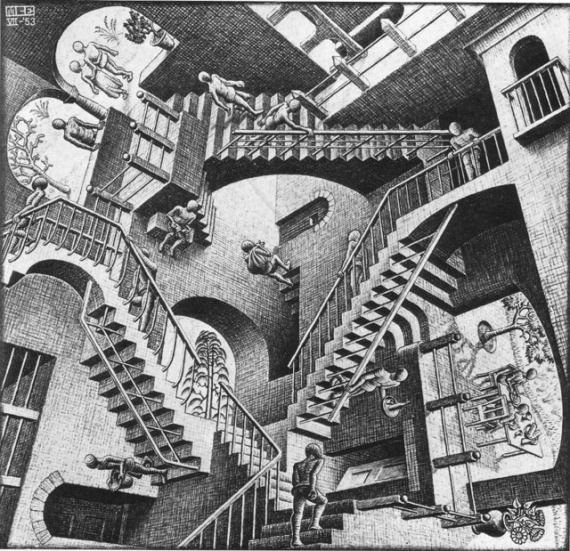
Relativity by Maurits Cornelis Escher (M.C. Escher)
The irrational idea that gravity exists in all directions within one house is intriguing, just like how unreal yet interesting a dream may seem. What I have in mind now is many girls on different directions of gravity doing the things I enjoy or holding the things I like.
Escher is a graphic artist. During his lifetime, made 448 lithographs, woodcuts and wood engravings and over 2000 drawings and sketches. He is most famous for his ‘so-called’ impossible structures, such as Ascending and Descending.
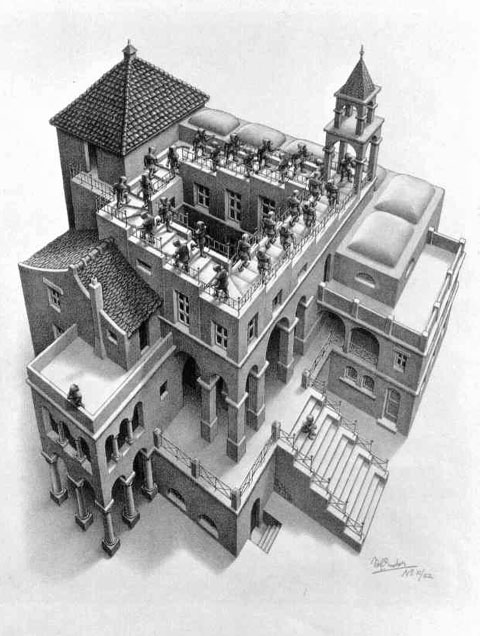
Ascending and Descending by M.C Escher
As I was searching around on the internet for mediums to express my theme, I stumbled upon this: Andrew Lipson’s LEGO® Page at http://www.andrewlipson.com/lego.htm. This guy managed to complete the relativity structure in using lego:
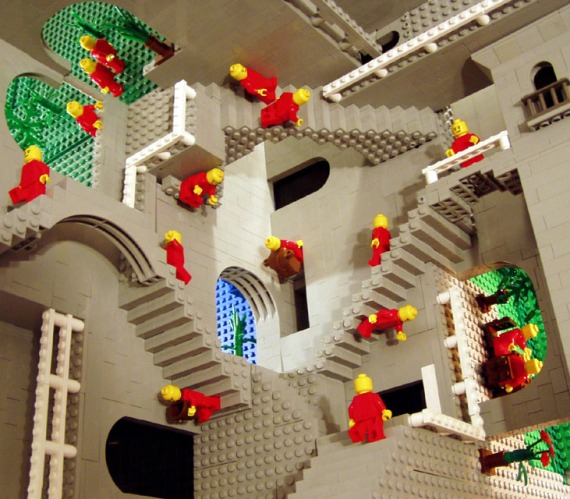
This is the complete structure he has made. The website also shows the building processes, methodology etc. Not only that, he has also succeeded in building many other structures of famous paintings (not limited to M.C. Escher) and statues using lego. It’s worth a look!
Other than that, I also found a 3-D software figure online here:
http://sketchup.google.com/3dwarehouse/details?mid=21b4c1477012a2875d8dee96b5a7691
In this website, the painting recreated in the form of 3-D structures using a special software, allowing you to examine the figure from different angles.
The last method I found, is photography, an idea I gained from United World’s College art exhibition.
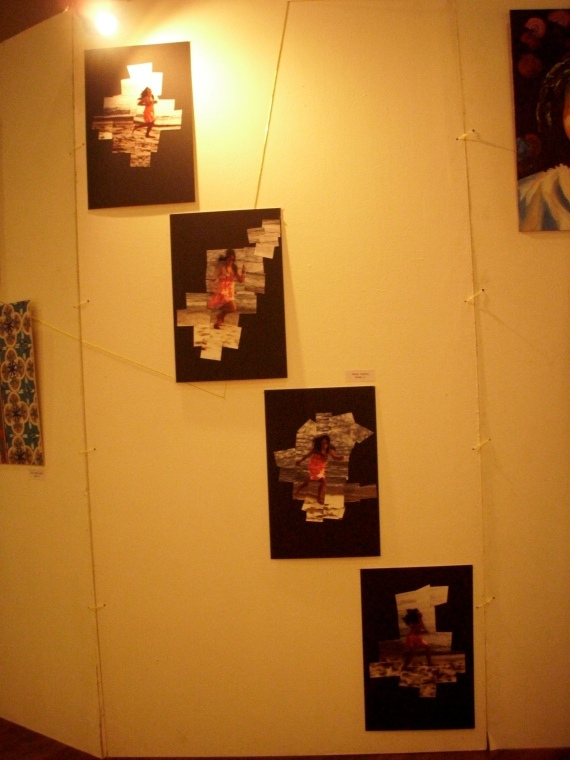
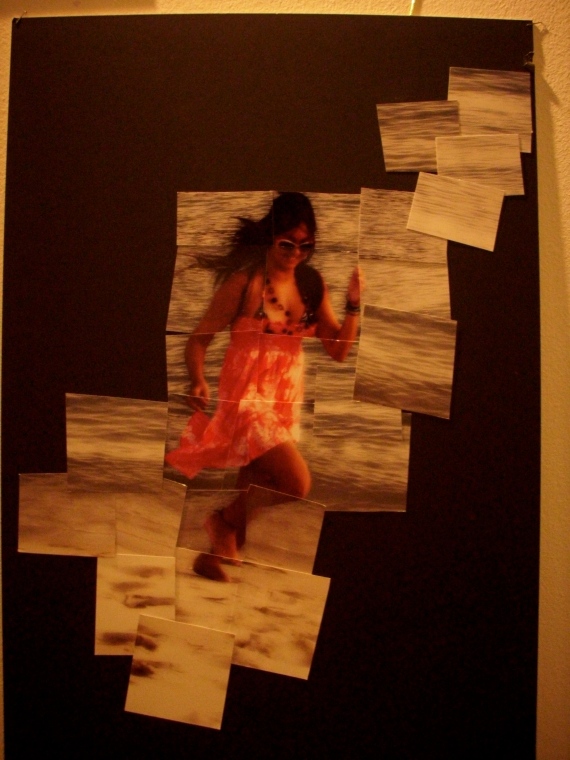
What I like about these series of photographs is the way each individual photo is being pieced together into one. It gives the dreamy effect just like how a dream comes in bits and pieces that might not match exactly.
Yep, and that’s all for this post.












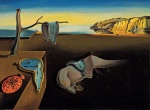
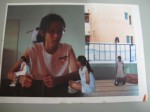

30 Sep
My comments and criticism
Posted by voicesofthemountains in Comments and criticism. Leave a Comment
http://destinyplan.wordpress.com/2009/09/28/sec-4-lifeskills-camp-design/#comment-44
http://asukacherry.wordpress.com/2009/04/05/artworks-i/#comment-27
http://kiyo0jinjin.wordpress.com/2009/09/28/last-year-paintings/nunu-opus-01/#comment-13
http://poohiefied.wordpress.com/2008/12/05/open-house-posters/#comment-10
http://liqiairgirl.wordpress.com/2009/04/26/cube/img_00011/#comment-22